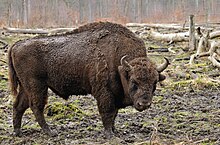Lowland Caucasus Line

The lowland-Caucasus line is the name given to a breeding line in the conservation breeding of bison, which is threatened with extinction . In addition to the genetic material of the lowland bison, all animals in this bison line also carry the mountain bison - genetic material of the Caucasus bull with the studbook number 100.
Wisents were threatened with extinction in the years after the First World War . The bison living in the wild in today's Białowieża National Park were poached immediately after the end of the First World War. The last animals of the mountain wisent were shot down in 1927. Efforts to conserve the species began in the 1920s and were aimed at conserving bison in general. They tried to get hold of all bisons that lived in zoos and enclosures. In addition to crossing bisons, no attention was paid to differentiating between mountain wisent and bison. The bull Caucasus, which descended from Caucasian, free-living mountain wisents and was brought to Germany in 1908, where it was mated with cows of the lowland wisent under breeding conditions, played a major role in the maintenance breeding. Since a sufficient stock of bison has been bred, more importance is attached to the preservation of the pure-blooded lowland bison. They form the so-called lowland line and are no longer mated with animals of the lowland-Caucasus line.
One of the best-known representatives of the lowland-Caucasus line is the bull Pulpit , who left his reserve in the Carpathian Mountains and crossed southern Poland several times in 1964 and 1965. He aroused great media interest because he sometimes found himself in peasant villages and small towns, where he took vegetables from market stalls and let school children feed him bread.
literature
- Małgorzata Krasińska and Zbigniew Krasiński : The Wisent , The New Brehm Library Volume 74, Westarp Sciences, Hohenwarsleben 2008, ISBN 978-3-89432-481-0
- Rüdiger Schröpfer: "Social structure of wild cattle of the genus Bison"